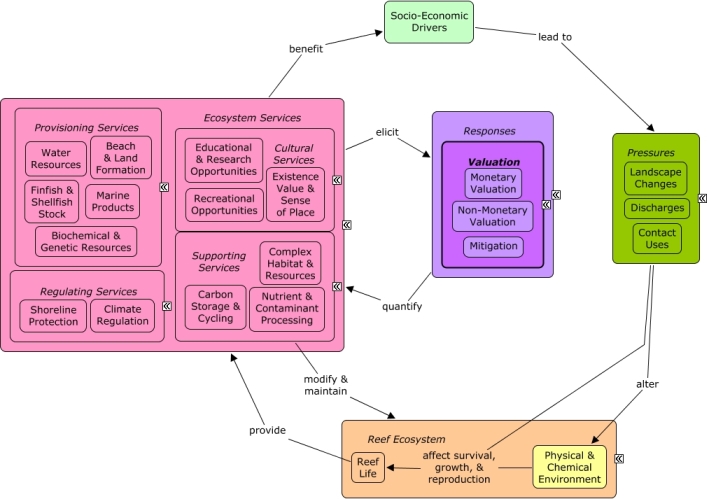ReefLink Database

Monetary Valuation
Monetary valuation involves methods to quantify the worth of ecosystem goods and services in terms of economic units (e.g. US dollars). Methods include market values for market-traded goods, or non-market values for non-traded benefits using revealed or state preferences, or cost-avoidance techniques (Hajkowicz 2007).
CMap

CMap Description
Valuation methods can be used to quantify the monetary or non-monetary value of coral reef ecosystem goods and services. Economic markets, demand, and availability of substitutable products can influence the value of ecosystem goods and services. Non-market traded services, such as recreational opportunities, may be valued indirectly through willingness-to-pay methods, value of replacement or substitutes, travel costs, or in the case of shoreline protection, value of avoided damages. Values may be useful for educational or informational purposes, or to evaluate different decision options in a cost-benefit analysis. A change in the value of ecosystem services, or a desire to increase the total value of ecosystem services, may elicit responses to protect or restore the reef ecosystem by reducing pressures.Citations
More than 50 citations. Click here to load.
| Citation | Year | Study Location | Study Type | Database Topics |
|---|
Management Options
| Management Option | Description | Sources | Database Topics |
|---|---|---|---|
| Damage Assessment, Documentation & Response: Natural Resource Injury Incident Litigation | This management option involves sharing information and documentation regarding an injury incident so that litigation teams can proceed with legal action against responsible parties. This is achieved through providing vessel grounding litigation management participation in order to process the information collected during assessment phase of injury to help build a case against the responsible party. Also, it involves providing vessel grounding litigation case management support through providing reports, site reconnaissance, deposition, and witness testimonies in support of litigation. Lastly it would involve documenting and tracking costs along the way from field assessment work, reporting, etc. | NOAA Marine Sanctuary Program. 2007. Florida Keys National Marine Sanctuary revised management plan. National Ocean Service, Key West, FL. |
Anchoring & Vessel Grounding; Boating Activities; Contact Uses; Mitigation; Monetary Valuation; Physical Damage; Resource Use Management; Security & Public Administration Policies; Security Policies; Valuation |
| Monitor & Research: Utilize Managed Areas for Socioeconomic Research | Data are needed to test hypotheses about the socioeconomic impact of marine zoning and user-group perceptions about changes in natural resources within the sanctuary area. User-group perception of changes in natural resources can be compared with quantitative ecological data to identify misconceptions and knowledge gaps. Providing funding opportunities for external scientists to conduct research in the managed area is another option. | NOAA Marine Sanctuary Program. 2007. Florida Keys National Marine Sanctuary revised management plan. National Ocean Service, Key West, FL. |
Contact Uses; Cultural Services; Culture; Decision Support; Designated Uses; Economic Markets & Policies; Ecosystem Monitoring & Restoration; Educational & Research Opportunities; Environmental Education & Outreach; Food & Raw Materials; Infrastructural Policies; Landuse Management; Marine Protected Areas; Monetary Valuation; Non-Monetary Valuation; Permitting & Zoning; Provisioning Services; Reef Habitat; Reef Inhabitants; Regulating Services; Resource Use Management; Special Use Permitting; Supporting Services; Valuation |
| Monitor & Research: Monitor Sanctuary Use Patterns and Resource Value | This management option seeks to provide data and analysis of consumptive and non-consumptive use of all natural resources within sanctuary borders. Special emphasis is to be placed on artificial and natural reef resources used by residents and visitors. Wherever possible, market and non-market values of these resources should be elicited as well. | NOAA Marine Sanctuary Program. 2007. Florida Keys National Marine Sanctuary revised management plan. National Ocean Service, Key West, FL. |
Biological Monitoring & Restoration; Contact Uses; Coral; Cultural Services; Economic Markets & Policies; Ecosystem Monitoring & Restoration; Marine Protected Areas; Monetary Valuation; Non-Monetary Valuation; Provisioning Services; Reef Habitat; Resource Use Management; Tourism & Recreation Policies; Valuation |
| Restoration: Environmental Remediation | Environmental Remediation is a type of restoration that's focus ranges from Brownfields to Oil Spills to Hazardous Waste Sites. These restoration activities aim to restore the site to a previous condition, or to a condition that is not a threat to human health or other forms of life. Several standards can be used to determine when remediation is necessary and to what extent the environment should be restores. Biocriteria can be used to determine the degree of degradation to biological components of the site. Often it is the presence of a particular pollutant in the soil, water or air, which is above acceptable limits and will not degrade fast enough over a short period of time and therefore must be removed. Physical and chemical water quality criteria can be used to set maximum acceptable limits of water quality parameters. Air quality criteria can be used to set acceptable maximum and minimum air standards for remediation. | Office of Solid Waste and Emergency Response. 2005. Contaminated Sediment Remediation Guidance for Hazardous Waste Sites. EPA-540-R-05-012, US Environmental Protection Agency. Environment Protection Authority. EPA Guidelines for Environmental management of on-site remediation. Environment Protection Authority, Adelaide, Australia. |
Applied Chemicals; Biocriteria; City Planning; Decision Support; Discharge Limitations; Discharges; Ecosystem Monitoring & Restoration; Environmental Monitoring & Restoration; Environmental Monitoring, Mapping, & Scientific Research; Food, Beverage, & Tobacco Products; Health; Health Policies; Landuse Management; Littering; Manufacturing & Trade; Metals, Electronics, & Machinery Products; Military; Mining; Mining Policies; Mitigation; Monetary Valuation; Nutrient & Contaminant Processing; Oil & Gas Industry; Oil & Gas Rigs; Oil & Gas Tankers; Petroleum Spills; Physical & Chemical Water Quality Criteria; Pipelines; Point Source Discharges; Public Administration; Remediation; Security; Solid Waste Disposal; Supporting Services; Toxics; Valuation; Waste Management; Waste Management Policies; Wastewater Discharge; Waterborne Discharges; Wood, Plastics, & Chemical Products |
Laws
| Legal Citation | Purpose of Law | Management Organization | Database Topics |
|---|
